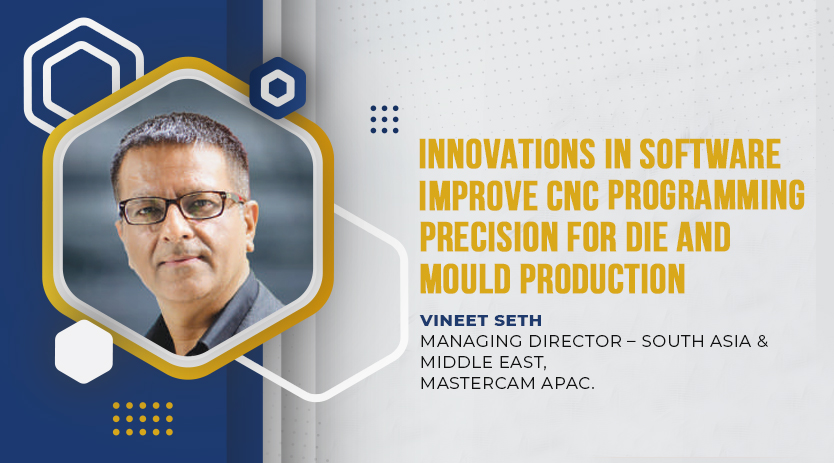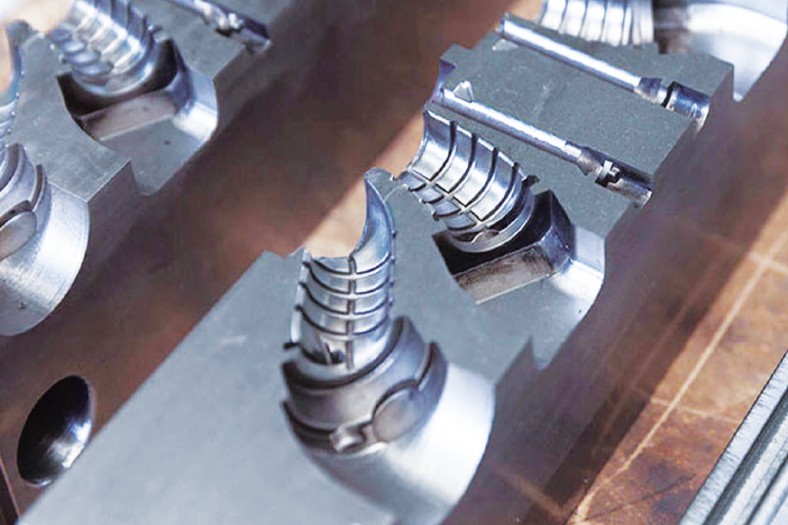Innovations in software improve CNC programming precision for die and mould production
September 30, 2023 2:43 pm
Vineet Seth, the Managing Director of Mastercam APAC for South Asia & Middle East, asserts that CNC machines are indispensable in die and mould manufacturing, serving as the backbone of discreet production processes. Their affordability, versatility, and unparalleled precision and efficiency make them invaluable. Seth also highlights the significant impact of recent CAD/CAM software advancements on enhancing CNC programming.
What key factors drive the shift towards advanced manufacturing techniques in the die and mould industry?
The die and mould industry has recently witnessed a decisive shift towards advanced manufacturing techniques, particularly in multi-axis and multi-tasking machining. This shift has seen manufacturers adopt advanced manufacturing techniques, particularly in multi-axis and multi-tasking machining. They increasingly embrace cutting-edge software solutions to optimise machining processes, enhance efficiency, and achieve superior precision. As a result of these progressive manufacturing trends, there has been a noticeable reduction in manufacturing lead times and an overall improvement in the quality of moulds and dies. This has made manufacturers more competitive and pushed the boundaries of what can be achieved in terms of complexity and precision in their products.
Furthermore, on the automation front, robots play a pivotal role in elevating mass production and precision. They are deployed for various tasks, including material handling on and off machines and machining large moulds for advanced composite materials. Integrating advanced sensors and software with these robots increases accuracy, producing high-quality end products. Moreover, robots’ ability to operate continuously around the clock ensures reduced downtime and a substantial increase in production capacity.
How are manufacturers adapting their operations and skillsets to fully leverage sophisticated tools for enhanced precision and efficiency?
CAD and CAM technologies are fundamentally reshaping the future of die and mould manufacturing in numerous ways. CAD facilitates the creation of intricate and innovative moulds and die designs with exceptional precision. CAM software, such as Mastercam, complements this by generating efficient tool paths that minimise machining time and material wastage. Through their advanced features and capabilities, CAM software offers sophisticated toolpath strategies that optimise machining processes, reduce cycle times and enhance efficiency. Multi-axis machining capabilities enable intricate contouring and precise surface finishing, addressing the complex geometries often found in dies and moulds. Simulation and verification tools help identify and rectify errors before they occur, minimising scrap and rework. Customisation and automation options streamline workflows, while efficient toolpath editing ensures precise control over machining operations. Further, seamless integration with CAD facilitates a smooth transition from design to manufacturing, and comprehensive tool management features enhance tool selection and usage tracking. As further development occurs in the respective domains, this software empowers manufacturers to remain competitive by consistently producing complex, high-precision, efficient and quality components.
What new advancements have occurred in CAD/CAM software tools for CNC programming needs?
CAD/CAM software tools have seen significant advancements in recent years. These improvements encompass various aspects of CNC programming. User interfaces have become more user-friendly, simplifying the toolpath creation process. Multi-axis machining capabilities have expanded, enabling the production of complex parts in shorter times. Furthermore, software algorithms now offer toolpath optimisation, leading to reduced cycle times and minimised tool wear. These developments signify a continuous effort to enhance efficiency and precision in CNC programming for die and mould manufacturing. Specifically, advancements have been made to offer more precise visualisation of multi-tasking machining processes, facilitating collision detection. Robust support for live tooling allows for milling and drilling operations in a single setup, while synchronised tool paths streamline complex operations.
Additionally, improved post-processing capabilities generate CNC code tailored to multi-tasking machines. Furthermore, integrating hybrid machining enables combining subtractive and additive processes in one setup, helping manufacturers accomplish end-to-end manufacturing in a very small real-estate footprint. Comprehensive material libraries cater to additive manufacturing requirements, and Toolpath optimisation reduces cycle times and enhances machining quality.
What innovations and developments in CNC and CAM can we anticipate to further optimise precision, speed, and efficiency in die and mould manufacturing?
In the realm of die and mould manufacturing, CNC (Computer Numerical Control) machines are the workhorses, carrying the entire discreet and production manufacturing on their backs due to their affordability, range, exceptional precision and efficiency. Think of them as the artisan’s tools for crafting intricate masterpieces. For instance, when creating moulds for precision-engineered aerospace components, CNC machines ensure that every contour and detail align flawlessly, meeting the stringent standards of the aerospace industry. Similarly, CNC machines work tirelessly in the automotive sector to produce intricate dies used in manufacturing complex vehicle components. These machines go beyond mere automation; they orchestrate continuous production, significantly cutting down on lead times and enhancing overall operational efficiency. While many complex Dies and Moulds were made even before CNC machines, the time and cost required to make them today has exponentially reduced, increasing reliability and accuracy by miles – thanks to CAM software and CNC machines!
How is the growth of injection moulding impacting the die and mould industry?
The continued expansion of the injection moulding sector exerts a direct influence on the die and mould industry. Mould manufacturers progressively accommodate the increasing need for moulds essential in producing diverse injection-moulded items. Given plastic’s intrinsic moldability, even in exceptionally delicate and intricate configurations, plastic injection moulds typically require rigorous precision machining and unique surface finishing processes. Consequently, this trend drives the demand for CNC machinery, cutting-edge manufacturing methodologies, contemporary CAD/CAM systems, compact and highly efficient cutting tools, and advanced high-performance cutting fluids, among other technological requisites. We can see how this impacts various markets, businesses and macro-economics.
How are additive manufacturing and 3D printing influencing the production of components and equipment parts in India?
Additive manufacturing and 3D printing technologies are revolutionising component and equipment part manufacturing in India and worldwide. These technologies offer rapid prototyping capabilities, expediting mould development and die development. They excel in producing components with complex geometries – especially conformal cooling in complex cores and cavities for moulds, all while minimising material waste. The flexibility and speed of additive manufacturing enhance manufacturing capabilities and enable innovative solutions in the die and mould industry, ultimately increasing efficiency and encouraging design freedom.
What material and design innovations are shaping the progress of the die and mould industry?
The die and mould industry has witnessed significant innovations in materials and design techniques, fostering greater efficiency, durability, and adaptability in mould and die manufacturing/production. These advancements encompass high-performance tool steels with enhanced hardness and wear resistance, novel coatings like diamond-like carbon and titanium nitride for improved surface properties, and integrating 3D printing and additive manufacturing to create intricate mould components and cooling channels. Composite materials blending metals and ceramics are gaining traction for their exceptional thermal stability and durability, ideal for high-volume manufacturing. Moreover, innovations like conformal cooling design, simulation software, and digital twin technology are streamlining the optimisation of mould designs and real-time production monitoring. Specialised materials for demanding applications and a focus on sustainability through light-weighting techniques further underscore the industry’s commitment to advancing mould and die technology – especially in aerospace and medical applications.
What latest developments have occurred in the die and mould industry to support the EV industry?
The burgeoning electric vehicle (EV) industry catalyses developments within the die and mould sector. Manufacturers produce custom moulds tailored to the specific components required for EVs, such as battery casings and motor components. Material advancements are another crucial facet, focusing on developing materials optimised for EV components, considering factors like heat dissipation and weight reduction. These developments validate and demonstrate the adaptability of the die and mould industry to meet the unique demands of the rapidly expanding EV sector.
Cookie Consent
We use cookies to personalize your experience. By continuing to visit this website you agree to our Terms & Conditions, Privacy Policy and Cookie Policy.









